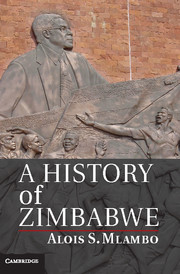Book contents
- Frontmatter
- Dedication
- Contents
- Figures
- Tables
- Maps
- Acknowledgements
- Timeline
- Notable Figures in Zimbabwean History
- 1 Introduction: Zimbabwe in Historical Perspective
- 2 Early States, c. 900–1900
- 3 The British Conquest State
- 4 Colonial Economy and Society to 1953
- 5 The Federation Years, 1953–1963
- 6 Nationalist Movements to 1965
- 7 Unilateral Declaration of Independence and African Response
- 8 Independent Zimbabwe, 1980–2000
- 9 The Crisis Years, 2000–2008
- 10 Conclusion: Zimbabwe Past, Present and Future Prospects
- Select Bibliography
- Index
- References
5 - The Federation Years, 1953–1963
Published online by Cambridge University Press: 05 June 2014
- Frontmatter
- Dedication
- Contents
- Figures
- Tables
- Maps
- Acknowledgements
- Timeline
- Notable Figures in Zimbabwean History
- 1 Introduction: Zimbabwe in Historical Perspective
- 2 Early States, c. 900–1900
- 3 The British Conquest State
- 4 Colonial Economy and Society to 1953
- 5 The Federation Years, 1953–1963
- 6 Nationalist Movements to 1965
- 7 Unilateral Declaration of Independence and African Response
- 8 Independent Zimbabwe, 1980–2000
- 9 The Crisis Years, 2000–2008
- 10 Conclusion: Zimbabwe Past, Present and Future Prospects
- Select Bibliography
- Index
- References
Summary
Introduction
In 1953, Southern Rhodesia joined two other Central African countries, Northern Rhodesia (Zambia) and Nyasaland (Malawi), in a three-nation political and economic unit known as the Central African Federation (CAF). Also known as the Federation of Rhodesia and Nyasaland, it collapsed in 1963 because of the impending independence of Northern Rhodesia and Nyasaland in 1964, as well as because of mounting African hostility to it in all the three territories. Only two prime ministers led the Federation before its collapse, the first one being the hitherto long-serving prime minister of Southern Rhodesia, Godfrey Huggins, from 1953 to 1956. The second and last prime minister was Northern Rhodesian political leader Roy Welensky who presided over the union from 1956 until its dissolution.
The Federation was a product of geopolitical, economic and political considerations on the part of both the white inhabitants of the three territories and the colonial power, Britain, which encouraged political and economic amalgamation of its central African territories for reasons that had to do with the opportunity a large economic and political entity would provide in terms of markets as well as its role as a buffer against possible Apartheid South Africa’s influence in the region. The origins and development of the Central African Federation are discussed in the following sections.
- Type
- Chapter
- Information
- A History of Zimbabwe , pp. 119 - 127Publisher: Cambridge University PressPrint publication year: 2014



